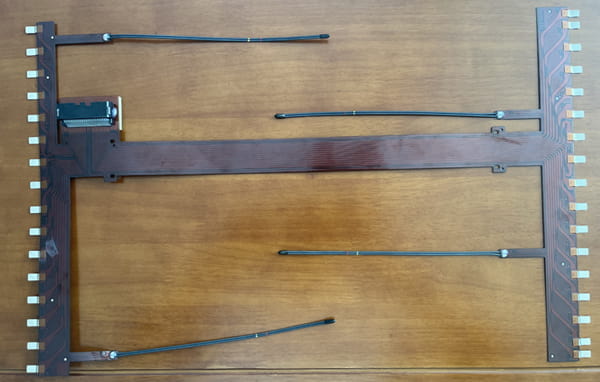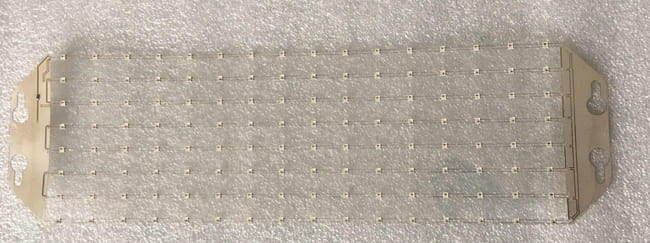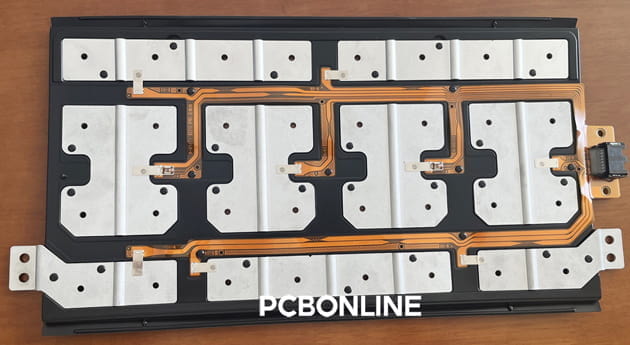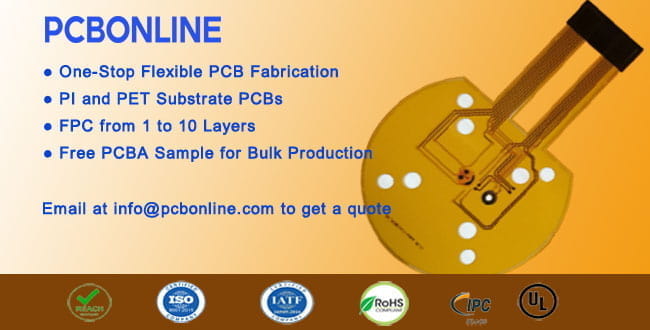Flexible PCBs can be single-layered, double-layered, and multilayered. Single and double-layered flex PCBs are more uncomplicated, and you don't need to worry about their thickness. For higher circuit density and more functions, you may need the more complex multilayer flex PCBs for your project.

To a multilayer flex PCB manufacturer, you may have quite some questions to ask, like, how many layers of flexible PCBs can be made, what the final board's thickness is, which type of flexible copper-clad laminate (FCCL) for the PCB can be... Now, you can find answers to these questions.
You can read a comprehensive guide to multilayer flex PCB design and fabrication here, including a PCB overview, the types of FCCL, and flex PCB manufacturing capabilities such as finished board thickness.
Part 1: Overview of Multilayer Flexible PCB
![]()
Flexible PCBs are composed of FCCL and polyimide (PI) or polyester (PET) materials. A flexible multilayer PCB is a flexible printed circuit board with more than 2 copper layers. It can be single or double-sided.
From a one-stop flex PCB manufacturer PCBONLINE, multilayer flex PCBs can be PI flex PCBs of 3 to 10 layers and transparent PET PCBs of 3 to 6 layers. The flexible material can be laminated with other types of materials, such as FR4 of any Tg and PTFE (Teflon).

For easier connection with rigid PCBs, hardware, or sockets, stiffeners including FR4, PI, or stainless steel can be added to flex PCBs.
Due to the many copper layers, by using multilayer flex PCBs, you can create higher-density circuits and save more space and weight for the application. Plus to the advantages of flexible PCBs, multilayer flex PCBs can bend, stretch, and pull back in a three-dimensional space, and fit in a very narrow space to connect different parts of a system and conduct signals.

Multilayer flexible PCBs are used in various electronic devices, such as smartphones, tablets, lithium battery systems, car door handles and hinges, decoration, and tail lights in automotive vehicles, beauty face lights, and so on.
If you want multilayer flexible PCBs for applications that require much flexibility, and you want the PCB thickness to be small, you may need flex PCBs made of FCCL using rolled annealed copper without adhesive.
Part 2: Types of Multilayer Flex PCBs
FCCL is the laminate for flexible PCBs including rigid-flex PCBs. It is made up of alternating layers of copper foil and PI or PET. The types of copper foil and PI determine the key features of multilayer flex PCBs, such as thickness and flexibility. According to different PI of FCCL, there are glued and adhesive-free multilayer flex PCBs. According to the different copper foils of FCCL, there are RA copper and ED copper multilayer flex PCBs.
The PI of FCCL for flex PCBs includes two types, one is coated with adhesive, and the other is without adhesive.
Glued multilayer flex PCBs
FCCL with adhesive is made by bonding copper foil and PI films coated with adhesive. The adhesive has poor heat resistance, dimensional stability, and chemical resistance. Multilayer flexible PCBs made of FCCL with adhesive can't work at temperatures above 200°C, and when the temperatures reach 120°C, the tear strength goes down dramatically. But as you know, the lamination temperatures for rigid-flex PCBs easily reach 200°C. For this reason, FCCL with adhesive can't be used in rigid-flex PCBs, and they only work for flexible PCBs at temperatures lower than 200°C.
Adhesive-free multilayer flex PCBs

Adhesive-free FCCL can be fabricated in two ways. One is to use PI film as the carrier and dip-coat copper foil on its surface. The other is to use copper foil as the carrier to coat liquid PI on the surface and then cure it. Adhesive-free multilayer flex PCBs have few dimensional changes at high temperatures. Even at 300°C, the dimensional change rate of the FPC is still within 0.1%. The excellent dimensional stability of the adhesive-free multilayer flex PCB makes fine lines accessible in it. Today, high-end electronic products such as LCD, PDP, and COF boards all emphasize fine lines, high density, high dimensional stability, and high-temperature resistance. That's why adhesive-free multilayer flex PCBs are used more and more. From PCBONLINE, the minimum trace width/space is 1.6mil/1.6mil.
Copper foil of FCCL for multilayer flex PCBs also includes two types. One is rolled annealed (RA) copper, and the other is electrodeposited (ED) copper.
RA copper multilayer flex PCBs
RA copper is extruded to the required thickness by heating and rolling on an FCCL. It is very resistant to bending. Rigid-flex PCBs and flexible PCBs to move frequently in use must use RA copper FCCL. When the copper thickness is below 0.5oz, the smaller the copper thickness, the higher the RA copper multilayer flex PCB price. According to the FPC manufacturer PCBONLINE, the minimum copper thickness of RA copper flex PCBs is 25μm. The surface of RA copper is smooth, so generating circuits on RA copper foil is generally by laser.
ED copper multilayer flex PCBs
On an FCCL, ED copper is sputtered or electroplated to reach the required thickness. The larger the copper thickness, the higher the ED copper FCCL price. According to the PCB manufacturer PCBONLINE, the maximum copper thickness of ED copper multilayer flex PCBs is 3oz. ED copper is not resistant to bending but is easier to etch. Usually, ED copper multilayer flex PCBs are only for static uses, such as fitting in the cover of the lithium battery system to connect the circuits and transfer battery unit signals, LED light PCB beauty masks to shine on the face, many types of automotive lights such as walling lights, door lights, position lights, marker lights, etc.
Overall, adhesive-free multilayer flexible PCBs are thinner and lighter. Glued flex PCBs are less expansive than adhesive-free flex PCBs but their heat, dimensional stability, and anti-tear performances are worse. Multilayer flexible PCBs are much more resistant to bending and suitable for dynamic uses. If you want rigid-flex PCBs or high-performance multilayer flexible PCBs, let the flex PCB manufacturer use adhesive-free RA copper FCCL for production.
Part 3: Multilayer Flexible PCB Fabrication and Assembly
The flexible PCB fabrication process involves designing the PCB, manufacturing the FCCL, cutting the FCCL and PI/PET films to the required size, generating circuits on FCCL by imaging and etching or laser, circuit testing, layer alignment and lamination, surface finishing, silkscreen printing, baking, and cutting edges. More than 20 production lines are there in a flex PCB factory. You can check the fabrication video below.
The multilayer flex PCB assembly requires the SMT process, but the boards need to be fixed on the rigid surface of a jig to prevent dimensional moves during the assembly process.
To obtain multilayer flexible PCBs and PCB assembly, whichever type they can be from the above, you can work with the source factory flex PCB supplier PCBONLINE. PCBONLINE has three manufacturing bases for flexible PCB fabrication and assembly, one is an FCCL laminate factory, one is a flexible PCB factory, and one is an EMS PCB assembly factory.

By working with PCBONLINE, you can have multilayer flex PCBs manufactured and assembled at one stop and enjoy many benefits:
- You can save much money and time since PCBONLINE provides one-stop fabrication from FCCL and FPC fabrication to assembly.
- PCBONLINE offers one-on-one engineering support and can take part in the R&D of your project from the early developing stage.
- Besides regular PI flex PCBs of 1 to 10 layers, you can order transparent PET flex PCBs from 1 to 6 layers.
- High-quality multilayer flex PCBs certified with ISO 9001:2015, IATF 16949, IPC, RoHS, REACH, and UL.
- After flex PCB assembly, PCBONLINE also provides comprehensive services like IC programming.
You can check PCBONLNE's multilayer flexible PCB fabrication capabilities here:
- Finished PCB thickness: 0.08mm to 1mm
- Minimum width of finished PCB: 2.6mm
- PCB copper thickness: 25μm to 3oz
- Minimum line width/space: 1.6mil/1.6mil
- PCB color: yellow, white, black, or transparent
- Surface finish: immersion gold (ENIG), OSP, carbon ink, immersion silver, immersion tin, hard gold plating
- PCB quantity: 1 to 100,000+ (price calculated according to weight)
In the past 24 years, PCBONLINE has provided clients around the globe with flex PCBs, including PI flex PCBs, clear PET flex PCBs, flex aluminum PCBs, rigid-flex PCBs, and hybrid flex PCBs, for medical, automotive, computing, communications, defense, and other industries that require high-reliability electronics.
If you work in an original equipment manufacturer (OEM), research institute, or business maker, the one-stop flex PCB manufacturer PCBONLINE can provide you with the most considerate EMS services and multilayer flex PCBs/PCBA of extraordinary quality. You can enjoy free samples and flexible payment terms. If you want to get a quote, you can send your Gerber to info@pcbonline.com.
Conclusion
Multilayer flex PCBs have more than 2 layers of conductive traces, and rigid-flex PCBs belong to this category. They not only have all the metrics of 1 or 2-layer flexible PCBs but also provide more design space and possibility for high-density circuits. Besides, other materials such as FR4 and PTFE can be hybrid laminated with the PI or PET flexible PCB layers to create hybrid substrate PCBs. Working with a reliable one-stop manufacturer is critical to the success of a multilayer flex PCB project. By working with PCBONLINE, you can enjoy one-on-one engineering support to enhance your design and have PCBs and hardware building without hassle.
© This article is an original work of the PCBONLINE team. Please indicate the author PCBONLINE if you reprint. If the article is reproduced without permission or indicating the author's source, PCBONLINE reserves the right to investigate the infringement.




